Recent Articles
Popular Makes
Body Types
2006 Chevrolet HHR Road Test
Chevy offers up a ho-hum ride

TO THE POINT What’s New? The 2006 Chevrolet HHR is all new. Selling Points: Rugged cargo floor; forthcoming rebates are almost certain Deal Breakers: Weak engines, uninspired handling, and cheap interior materials Our Advice: Skip this “all-new” ride that fails to compete with the similar Chrysler PT Cruiser. These days, every organization from CNN to the Times-Daily-Picayune contains a news item related to the hardships of domestic automotive giant General Motors. Fledgling sales and decreased market share, a disproportionate mix of SUVs for a fuel-conscious buying public, bankruptcy scares, and legacy costs make GM fodder for seemingly endless headlines. But the giant is stirring, shaking off excess baggage in a determined bid to whip itself into fighting condition. Validation is served by the improved Chevy Impala and the all-new Pontiac Solstice, among others. These signs of product life make the release of the 2006 Chevrolet HHR quite puzzling. This mediocre copy of the aging Chrysler PT Cruiser is little more than over-the-counter relief when GM needs the good stuff from the pharmacist’s private stock. As Olympic hopeful Nancy Kerrigan so eloquently put it, “Why? Why? Why?” Why, GM, and especially Chevy designers, would you copy a model that Chrysler has nearly milked dry over the past several years with your own warmed-over interpretation that must suffer from some serious horsepower envy? To top it off, handling akin to a cardboard box is tossed in along with a bunch of cheap plastic parts and real-world fuel economy that falls short of 22 mpg. Maybe everyone at Chevy was concentrating on the development of the stellar Corvette Z06, leaving little time for sweating the HHR’s details. The Chevy HHR is, according to its manufacturer, a sales success, one of several emerging bright spots. But after a week behind the wheel of the HHR LT1 with the optional 172-horsepower engine and automatic transmission (the most common model), a reason for purchasing it escapes us. There are better new and used cars available, vehicles with more power, better handling, and in many cases superior warranty coverage. However, for Chevy fans who’ve been gnawing at the bit for a small wagon that offers some utility and basic comfort accented by a driving character devoid of any spirit, consider the HHR the ultimate fix.
Performance
Key Points: • Standard 2.2-liter, inline four • Optional 2.4-liter, inline four • 143 horsepower (2.2L); 172 horsepower (2.4L) • Five-speed manual (standard); Four-speed automatic (optional) • 30 mpg on the highway with either transmission Among the things we like about the 2006 Chevrolet HHR, performance is near the end of a short list. Even with the optional 2.4-liter engine, which boasts 29 more horses than the standard motor, the Heritage High Roof (HHR) feels underpowered. Dig deep into the throttle, as is required to get any response for highway passes, and the cabin fills with raucous engine noise, though pinning the accelerator forces the smooth four-speed automatic transmission to downshift and get things moving. Around town, the HHR speaks with a mundane hum akin to the 1983 Chevy Celebrity – probably not the kind of retro engineers were going for. The powertrain is perfectly competent, but utterly devoid of any liveliness. With the low fun quotient, drivers may expect the 2006 Chevrolet HHR to offer impressive fuel economy. That’s far from the case, unless one considers city mileage in the low 20s and highway mileage peaking at 30 mpg, for an underpowered four-cylinder, to be noteworthy. Those numbers failed to overwhelm us with positive emotion, so an average of 21.8 mpg after a week of mixed driving was especially disappointing.
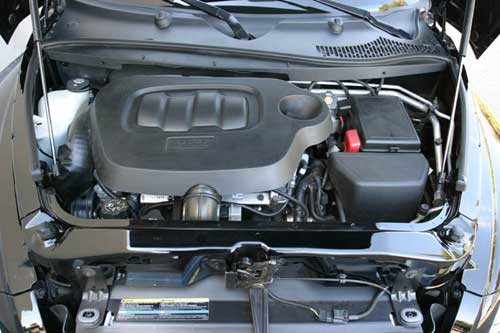
Handling
Key Points: • Front-wheel-drive • Independent front/semi-independent torsion beam rear suspension • Optional sport suspension • 16-inch wheels standard; 17-inch alloys optional • Front disc and rear drum brakes; ABS and traction control optional There’s one word that perfectly describes the handling characteristics of the 2006 Chevrolet HHR – average. The brakes are well modulated and do a fine job of stopping the car, but they’re not great. A four-wheel disc system, rather than the disc/drum setup that’s used, would likely prove to be more responsive. Bumps and potholes are dealt with quickly by the suspension, though a fair bit of body roll is evident at even modest speeds, and our test car’s 215/55R16 Firestone Affinity tires quickly begged for mercy when challenged. Vague steering with a significant dead spot on center fails to add any zest to the ride, though more effort is required at higher speeds, serving to at least simulate road feel. Drivers seeking a more responsive HHR can opt for a high-end model with the optional 2LT Equipment Group which adds a sport suspension, larger 17-inch wheels and tires, antilock brakes, and the 2.4-liter engine. If you’ve just got to have this new little Chevy, spending $1,800 on the 2LT package may be worth it. Or better yet, there’s the Chrysler PT Cruiser with gobs more power and decent road manners.
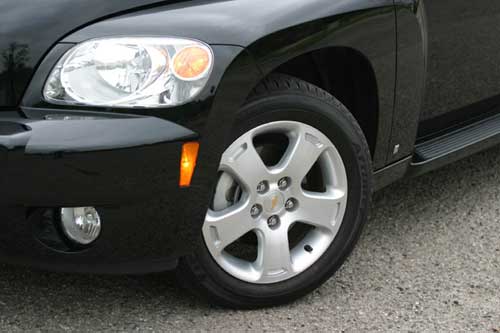
Interior Comfort
Key Points: • Ample headroom • Height-adjustable front bucket seats with fold-down armrests • Power driver’s seat with lumbar on LT • Rear 60/40 split bench seat • Heated seats and leather upholstery optional on LT From a comfort perspective, the 2006 Chevrolet HHR gets a passing grade, if not high marks. The front buckets feature flat bottom and back cushions with nary a bit of bolstering. However, the seats are ample with supportive cushioning, rendering them fairly comfortable, and LT models benefit from standard power adjustments, including lumbar. LS models make do with manual height adjustment for the driver. Door armrests are rubberized and thinly padded, while fold-down center armrests are well padded. A tilt-steering wheel, unfortunately wrapped with spongy plastic rather than leather, rounds out the driver’s accoutrements. Drivers will find visibility hindered by thick A- and D-pillars, small windows, and large rear headrests. Sizeable exterior mirrors serve to offset these deficiencies somewhat. Rear seat passengers are afforded the same flat cushioning as their forward counterparts, though there’s a nicely set recline position and the bench is firm enough to be supportive, yet soft enough to be comfortable. Large, adjustable headrests are provided for outboard passengers only, and a center armrest is not available. Head and foot room are generous, though taller riders will likely be scuffing their knees on the hard front seatbacks. Getting in and out of the 2006 Chevrolet HHR is aided by doors that open wide, while the tall front seats and rear bench provide a suitably comfortable hip point. Once planted and underway, the HHR’s occupants are subjected to a bit of wind noise at speed, and the unruly raucous nature of the engine when the throttle is pinned for maximum passing power.
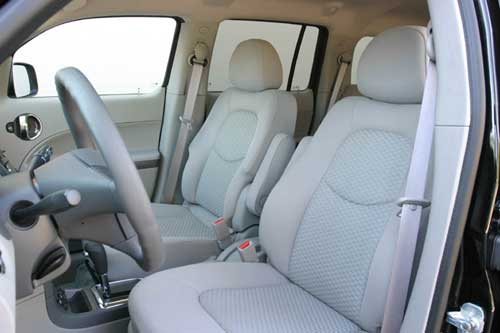
Interior Design
Key Points: • You want plastic? We got yer plastic right here… • And it’s all got goose bumps or some serious acne • Cheap feel to cloth seats • Chrome accents dress things up a bit • Available side-curtain airbags Regardless of whether or not the 2006 Chevrolet HHR mirrors the Chrysler PT Cruiser, it’s a new look for the bow tie brand. But inside, there’s an abundance of that familiar, dull Rental Gray. As far as the eye can see there are plastics of various shades and grains, with expansive and overly flexible panels affixed to the doors. Likewise, hard, low-grade materials cap the dash, and it all features a pronounced and bumpy grain that resembles goose pimple flesh, providing not only an eyesore but also a rough surface to touch. Door inserts are slightly padded, though covered in what seems to be a step below cheap vinyl. On a more positive note, designers have used a nice charcoal plastic to dress up the instrument panel, and the radio and climate control buttons include textured rubber grips. Chrome trim on the door handles, shift surround, and vent and gauge rings adds a splash of sparkle to the otherwise depressing interior. A quality mesh material, looking quite out-of-place in the HHR, is stitched to the visors and headliner, though the pillar covers are a hard plastic designed to look like mesh. Given that the 2006 HHR is an all-new car for Chevy, designers obviously spent some time working on this vehicle, but it looks like time was short when it came time to focus on the cockpit, and the result is a generic look and feel not deserving of buyers’ attention. And if you don’t buy that assertion, consider a comparison with the redesigned Honda Civic. Granted, the Civic lacks the HHR’s utility, but that point aside, the Civic comes fully loaded, including a navigation system, a plethora of airbags, and a power sunroof, for less than our Chevy’s as-tested price. Plus, it’s arguably more comfortable and built with superior materials. For a more apples-to-apples approach, the Chrysler PT Cruiser GT costs a bit more than our HHR tester, yet features a more upscale and inviting interior, not to mention 58 extra ponies under the hood.
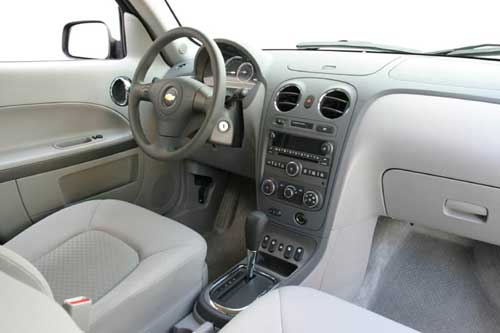
Control Layout
Key Points: • MP3 player standard on LT, optional on LS • Available six-disc CD changer and subwoofer • Auxiliary iPod jack • Power window controls on center console, just where you wouldn’t look • Steering wheel controls for cruise control and trip computer Given the rudimentary powertrain, basic five-passenger layout, and intentionally old-school styling, one may expect the 2006 Chevrolet HHR to be an example of simple ergonomics at is finest. Yet, all is not well in this land of oddly-placed switches and buttons. Shedding light on the situation is a single, bright bulb directed from where most people would expect to find a front dome lamp or map lights. In a sure sign of ingenuity, GM designers placed a light in the headliner that dimly illuminates the instrument panel at night. Neat, huh? Or maybe just a clever way to avoid using illuminated switches for the power windows, switches that are curiously placed at the bottom of the center console instead of on the door panel where, oh, maybe 99 percent of all drivers would expect to find them. Moving along with the complaint train, the HHR suggests a focus on audio entertainment with an auxiliary iPod jack and options like a six-disc CD changer and XM satellite radio, yet steering wheel stereo controls are only available as part of a $925 leather seat package. Such a popular and increasingly common feature should be easier, and cheaper to get. And finally there’s the fog light switch located on the right side of the instrument panel – drivers intuitively look to the left dash for this, and goodness knows there’s plenty of room on the 2006 Chevrolet HHR’s sea of gray dash plastic. On a more positive note, the radio controls are a study in minimalism, with clear indicators for seek and CD control and one knob for power and volume while another addresses tuning. Climate controls are equally pleasing, with three basic dials: Temperature, fan speed, and air flow direction.
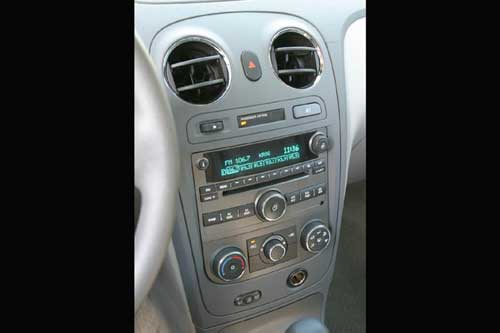
Storage and Cargo
Key Points: • Two front cupholders, one rear • Up to 63.1 cubic feet of cargo space • Multiple storage cubbies throughout • Comfortable load height for cargo floor • Roof rails optional on LT In terms of space, the 2006 Chevrolet HHR has something to offer cargo-toting buyers. The split rear seat folds to create an expansive floor covered in a hard, durable plastic. But remember to move the front seats forward first, or the rear headrests won’t clear the seatbacks. Below the load floor are a few storage wells of varying sizes, and on top are four tie-downs and a large cargo net good for keeping items secure. A large tailgate opening with a relatively low floor height makes for easy loading, but be careful not to scratch the bumper, as it lacks the protective pad found on similar vehicles. Also, keep an eye on the raised gate, sure to bump the skull of anyone over 5-foot-8-inches tall. Inside are three cupholders – two in the front of the center console and one in the rear. Each door features a small pocket, there’s a deep cubby on the top of the dash, a medium-sized glovebox is good for storing the owner’s manual and a few small items, while a storage net on the back of the driver’s seat is suitable for maps or rear passengers’ gear.
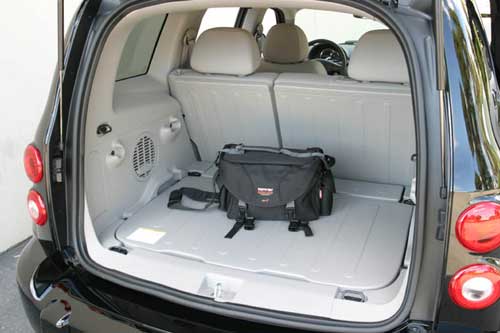
Exterior Design
Key Points: • Designed by same guy who drew the Chrysler PT Cruiser • Harkens back to Chevys of the 1940s • Attractive alloy wheels on LT • Chrome grille and door handles • Available color-keyed running boards Chances are you’ve heard the comparisons between the 2006 Chevrolet HHR and the Chrysler PT Cruiser, possibly to the point of making you sick. GM suggests that the HHR is an all-new design, separate from the PT, despite being designed by the same guy. Uh-huh. Bryan Nesbitt penned the PT before defecting to GM from Chrysler. The result is a front-wheel-drive, four-door wagon with retro styling including massive grilles and distinct fenders that mimic those of the 1940s, and running boards that just so happen to resemble the sculpted rocker panels of the PT Cruiser. That the HHR is a blatant copy of the PT should be obvious, though there are a few notable differences that give the Chevy an added dose of testosterone. The HHR has a blockier look, with a lower rear roof line and squared-off fenders and bumpers. The door frames and pillars offer more steel and less glass, but the rear quarter windows are larger, making the HHR appear longer, which it is by almost eight inches. Vertically-stacked round taillights further differentiate the Chevy, as does the license plate frame built into the tailgate instead of the bumper.
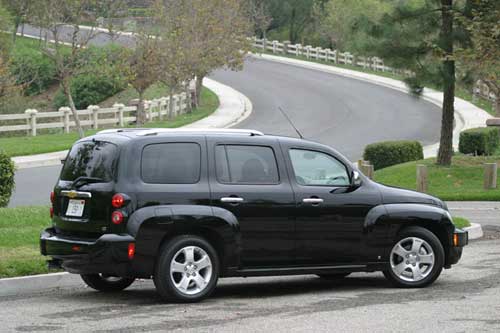
Build Quality
Key Points: • Large but consistent gaps • Exterior marred by misaligned panels If the 2006 Chevrolet HHR is any indication, General Motors is making good on its promise of improved build quality, albeit with baby steps. Visible inside are fairly large gaps around the dash and door panels, though they’re consistently wide if that’s any consolation. The generous swaths of plastic are quite flexible, but everything felt bolted down and secure. Observed on the exterior were slight misalignments along the edges of the hood and tailgate, while the left and right fenders exhibited varying gaps. Also, the optional running boards on our test car failed to sit flush with the body. As a whole, the HHR looks to be pretty well built, though there’s room for improvement.
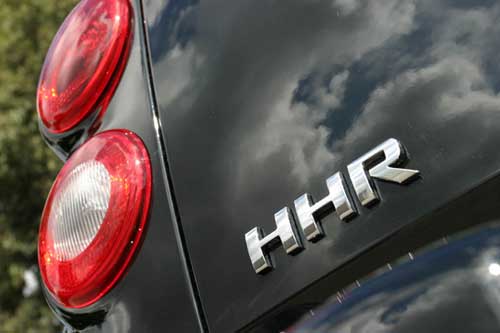
Specifications
Test Vehicle: 2006 Chevrolet HHR LT Price of Test Vehicle: $21,355 (including a $565 destination charge) Engine Size and Type: 2.4-liter four-cylinder Engine Horsepower: 172 at 6,200 rpm Engine Torque: 162 at 5,000 rpm Transmission: Four-speed automatic Curb weight, lbs.: 3,208 EPA Fuel Economy (city/highway): 23/30 mpg Observed Fuel Economy: 21.8 mpg Length: 176.2 inches Width: 69.1 inches Wheelbase: 103.5 inches Height: 63.1 inches Leg room (front/rear): 40.6/39.5 inches Head room (front/rear): 39.6/39.0 inches Max. Seating Capacity: 5 Max. Cargo Volume: 63.1 cubic feet Competitors: Chrysler PT Cruiser, Ford Focus Wagon, Honda Element, Hyundai Tucson, Kia Sportage, Mazda 3, Mazda 5, Mitsubishi Outlander, Pontiac Vibe, Saturn VUE, Scion xB, Subaru Impreza Wagon, Suzuki Aerio SX, Suzuki Forenza Wagon, Toyota Matrix
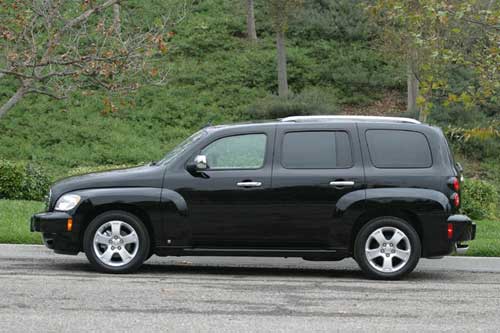
2nd Opinion – Wardlaw
Chevrolet insists that the new HHR (Heritage High Roof) is not a PT Cruiser clone, despite its pontoon fenders, rounded 1940s-style hood, four-cylinder engines, nearly identical seat design, and retro-wagon body shell. Yes, obviously, the 2006 Chevrolet HHR is a new kind of car. But I’d still rather own a Chrysler PT Cruiser. I drove an HHR in LT1 trim with a 2.4-cylinder engine matched with an automatic transmission – basically, the car that most people will buy. My route was mountainous, all two-lane roads – not the HHR’s natural habitat. So my comments must be taken in context. Note that my HHR averaged 23.1 mpg in this environment. The HHR’s most powerful engine choice is adequate at best, no match for the PT Cruiser’s optional turbo motor. Riding on all-season, P215/55R16 Firestone Affinity tires, my HHR was not set up for handling. The body rolled significantly in turns, and the HHR’s propensity for understeer is immediately apparent if you attempt to have any kind of fun behind the wheel. The electric steering is set up for low efforts and is easy to twirl for parking, but on sweeping curves you’ve gotta dial in lots of correction because there’s virtually no road feel. The best thing about driving the HHR is the way the brake pedal works, but on my test vehicle the front rotors caused a slight pulsation through the pedal. It’s not like a PT Cruiser is much better at gripping the road, but at least the two turbocharged engines provide a rush of acceleration and the GT model is tuned for rather impressive handling and grip. Behind the HHR’s steering wheel, the feel is exactly like a PT Cruiser, except the Chrysler provides a decidedly retro interior theme with body-color dash inserts, a trio of white-faced gauges, and a four-spoke steering wheel with a small center airbag cover. In the HHR, there’s lots of gray, a corporate three-spoke steering wheel, and conventional controls. But like the PT, the HHR’s driver’s seat is tall and firm, a little short on thigh support and includes an inboard armrest that sits too low to be of much use. There’s also a hard, deeply-grained plastic door panel devoid of power window switches. Those are placed in the middle of the car near the floor, opposite of where they’re located at the top of the center stack in the PT Cruiser. See, the Chevy different! In back, the HHR’s seat cushion is firm and sits high off the floor, and there’s lots of foot space under the front seats. Leg room is snug, but not uncomfortable. You can fit four large adults in this car. Just be careful getting in and out, because the decorative running boards could easily soil your clothes if they’re dirty. Built for utility, the HHR features a useful cargo hold. Fold the rear seats down to expand cargo space, but remember that the headrest must be removed first. And if you’re six-feet-tall, watch your head on the raised tailgate in the back. Styling is always a subjective matter, but I think the PT Cruiser is better balanced. The HHR has a big snout with lots of front overhang, and it’s more squared off in the rear. By comparison, the PT Cruiser is rakish, almost wedge-shaped front to rear, with better blended fender flares and an angled rear end. But the HHR’s faired-in taillights are a nice touch. After an hour behind the HHR’s wheel, I was ready to turn in the keys. That’s not my usual response to a Chrysler PT Cruiser – especially the speedy GT model. –
Photos by Ron Perry
